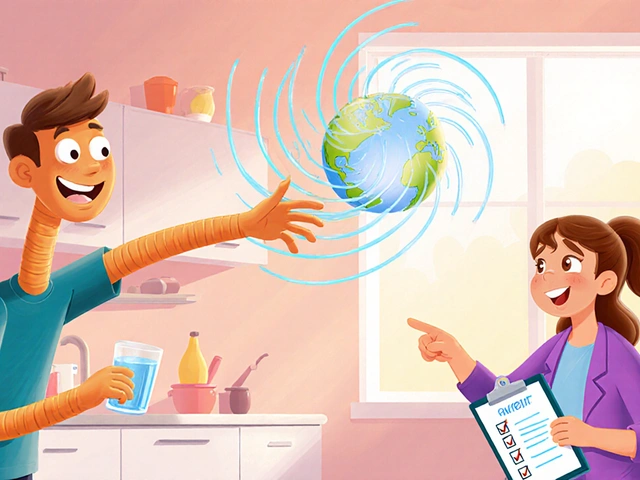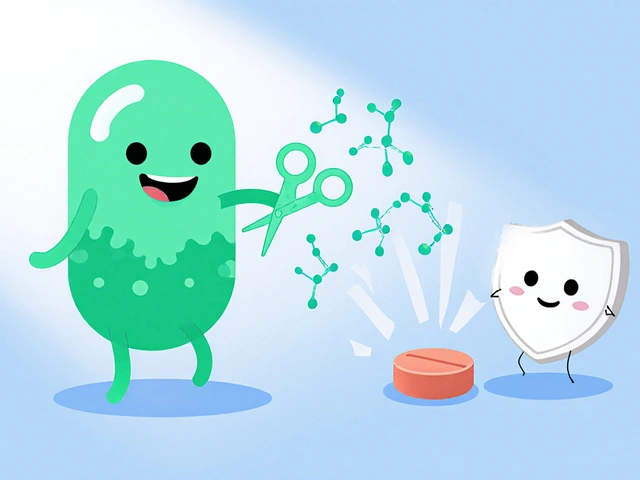Kaposi sarcoma might sound rare, but for some people, it’s a real worry—especially if you have a weakened immune system or live with HIV. The key thing to know: Kaposi sarcoma is closely linked with your body’s defenses against infection. If your immune system is strong, you’re way less likely to get it.
Most cases pop up in folks whose immune systems are down, often because of HIV or other medical problems. But here’s the good news—modern meds and smart choices can drop your risk a lot. Think about it like wearing a seatbelt: being proactive gives you a major advantage.
You don’t need to understand every medical term to protect yourself. A few small tweaks in your daily routine, regular check-ins with your doctor, and sticking to treatments can go a long way. Let’s walk through what matters most and what actually works if you want to avoid Kaposi sarcoma in your own life.
- What Is Kaposi Sarcoma, Really?
- Who Faces the Biggest Risk?
- The HIV Connection: Why Treatment Matters
- Simple Lifestyle Changes That Help
- Regular Check-Ups: Don’t Skip Them
- Looking Out for Loved Ones
What Is Kaposi Sarcoma, Really?
Let’s clear something up right away: Kaposi sarcoma (often called KS) is a type of cancer, but it’s not like the ones you hear about all the time. KS usually shows up as unusual spots or patches on your skin that can be purple, red, brown, or blue. These patches aren’t just on top of the skin—they can also pop up inside your mouth, nose, or even internal organs like the lungs or digestive system.
This cancer almost always ties back to something messing with your immune system. The real culprit is a virus called human herpesvirus 8 (or HHV-8). But here’s the weird bit: just having that virus isn’t enough. Most people with HHV-8 never get KS. It usually takes a beat-down immune system—think HIV or organ transplant medications—before KS even has a shot at showing up.
KS acts differently depending on your health. In people with healthy immune systems, it’s super rare. If you’re dealing with HIV and not on treatment, then KS can develop fast and get pretty serious.
Here’s a quick breakdown of where KS can appear and what you might notice:
- Skin: Spots (lesions) that are usually painless and flat or slightly raised
- Mouth: Purple or red patches, often on the palate
- Lymph nodes: Swelling in your arms or legs
- Internal organs: You won’t always see these, but you might notice trouble breathing or tummy pain if KS shows up inside
What really matters is this: KS is NOT contagious in the usual sense. You won’t catch it by hugging or sharing a drink. You do need to be exposed to HHV-8, and your risk jumps if your immune system is weak.
| Fact | Quick Info |
|---|---|
| Key Virus | Human Herpesvirus 8 (HHV-8) |
| Main Risk Group | People with HIV or other immune problems |
| Appearance | Reddish, purplish spots/lesions |
| Contagious? | No, not like the flu – requires HHV-8 |
The takeaway? You don’t need to panic if you see a random spot—but if you’re at risk, regular checkups and keeping your immune system solid make a real difference.
Who Faces the Biggest Risk?
Not everybody has to worry about Kaposi sarcoma. Certain groups end up with most of the risk, and it’s not random. If you’re aware of where you stand, you can make smarter choices and worry less about the unknown.
Folks living with HIV top the list. Before modern HIV treatments, Kaposi sarcoma was much more common among people with HIV. In fact, studies show that up to 30% of people with untreated HIV developed Kaposi sarcoma at some point. Nowadays, with meds that boost your immune system, the risk drops a ton—but it’s not gone entirely.
- People with HIV who aren’t on regular treatment (ART)
- Transplant patients taking immune-suppressing drugs
- Older men of Mediterranean or Eastern European descent
- People from certain parts of Africa, where a related virus is more common
Kaposi sarcoma happens when your immune system can’t keep a specific virus—called HHV-8 or Kaposi sarcoma-associated herpesvirus—in check. This virus usually doesn’t cause trouble unless your body has trouble fighting infections.
| Group | Estimated Risk Compared to General Population |
|---|---|
| HIV (untreated) | Up to 500x higher |
| Organ transplant recipients | About 150-200x higher |
| Older men (Mediterranean/Eastern Europe) | Lower, but still significant vs. average |
| General population | Very low |
The big thing to remember? If you’re not in these groups, your chance of getting Kaposi sarcoma is tiny. But if you are, a little vigilance pays off big time. Know your risk and stick to check-ups—especially if your immune system isn’t at full strength.
The HIV Connection: Why Treatment Matters
If you've ever googled Kaposi sarcoma, you’ve probably spotted that HIV keeps coming up in the results. That’s because people with untreated HIV have a much higher chance of getting Kaposi sarcoma compared to those with a healthy immune system. The reason is simple: when HIV isn’t managed, it lowers your immune defenses, letting the virus that causes Kaposi sarcoma (called HHV-8) do its thing. But here’s the kicker: sticking to HIV treatment drops your risk almost back to normal.
Modern HIV medicines, known as antiretrovirals or ART, are a game-changer. They keep your immune system strong by stopping HIV from making more copies of itself. When your body’s defense is doing its job, Kaposi sarcoma becomes pretty rare—even if you already carry the HHV-8 virus.
Check out how much treatment matters:
| Group | Chance of Kaposi Sarcoma |
|---|---|
| People with HIV (no treatment) | High |
| People with HIV (on ART) | Low |
| No HIV | Very Rare |
Here’s what makes the biggest difference if you’re living with HIV:
- Start treatment as soon as possible—even right after diagnosis is best.
- Take your meds every single day, no excuses.
- Work with your doctor to keep your immune system strong. Regular check-ups let you spot and treat any issues early.
Skipping treatment or missing doses is what brings on problems. Once your immune system is low, it’s much harder to get back on track. So, keeping up with HIV meds does more than just control HIV—it keeps you much safer from stuff like Kaposi sarcoma. That’s a win you don’t want to skip.

Simple Lifestyle Changes That Help
You don’t have to overhaul your whole life to reduce your chances of getting Kaposi sarcoma. A few straightforward habits can have a real impact, especially if you stick with them. Here’s what actually helps:
- Stick to your HIV treatment. If you’re HIV-positive, taking your meds like clockwork is the best defense. This keeps your immune system strong and your risk way down. A CDC report says, “People who take their HIV medicine daily as prescribed and get and keep an undetectable viral load have effectively no risk of transmitting HIV to their sexual partners and drastically cut cancer risk.”
- Eat a balanced diet. You’ve heard this before, but it counts. Fresh fruits, veggies, and lean protein keep your body ready to fight off all sorts of infections. Being seriously underweight or lacking healthy foods can make your immune system weaker.
- Don’t smoke. Smoking makes your immune system sluggish, and some studies even hint it could increase the risk for cancers like Kaposi sarcoma. Not smoking makes a measurable difference.
- Watch out for infections. Something as simple as treating cuts or seeing a doctor when you’re sick helps your immune system do its job. Chronic infections drain your body’s resources, giving diseases like Kaposi sarcoma a better shot.
- Regular exercise. You don’t need a gym membership. Even walking, cycling, or simple home workouts get your blood pumping and your immune system in gear.
How much can these choices help? A 2023 review in the Journal of Cancer Prevention found that people living with HIV who stuck to their treatment were about 90% less likely to develop Kaposi sarcoma compared to those who didn’t use medication regularly.
"Healthy lifestyle choices and consistent HIV management — that’s what changes the game for Kaposi sarcoma risk." — Dr. Elaine Fischer, Infectious Disease Specialist
Small changes add up. Just like brushing your teeth every day keeps your dentist happy, these steps help keep Kaposi sarcoma off your radar.
Regular Check-Ups: Don’t Skip Them
When it comes to Kaposi sarcoma prevention, keeping up with your regular check-ups is one of the smartest moves you can make. Catching things early gives you more options, and with immune health playing such a big role, your doctor can spot red flags you’d probably miss yourself.
If you’re living with HIV, you’ll want your provider to watch for skin changes or unexplained symptoms. They’re good at noticing when something’s off, especially in folks who are at higher risk. Even people with a healthy immune system but a family history of cancer should get checked at least yearly.
Here’s how regular visits make a difference:
- Your doctor can check for unusual spots, patches, or swelling that might be linked to Kaposi sarcoma.
- Blood tests keep an eye on your immune health and spot problems before you feel sick.
- They help you stick with your meds, especially antiretrovirals if you’re HIV-positive—these are game-changers for risk reduction.
- If your doctor sees anything odd, you can get a biopsy or further testing right away instead of playing catch-up later.
Missing visits isn’t just risky—it makes it easier for serious stuff to sneak up on you. A CDC report from 2023 actually showed that people with HIV who had consistent check-ups were half as likely to be diagnosed late with Kaposi sarcoma compared to those who skipped appointments.
| How Often? | Who? |
|---|---|
| Every 3-6 months | People with HIV or weakened immune systems |
| Every 12 months | People at general risk (family history, organ transplants, etc.) |
Bottom line: showing up for appointments keeps you a step ahead. If you ever notice new rashes, purple or brown spots, weird swelling, or anything out of the ordinary, don’t wait for your next check-up—let the doctor know right away. It might feel like a hassle now, but it’s a lot easier than dealing with cancer later.
Looking Out for Loved Ones
If someone you care about is at risk for Kaposi sarcoma or has already been diagnosed, your support matters more than you might think. Often, people with weak immune systems feel overwhelmed and alone. Being in their corner can make sticking to treatment and healthy habits much easier.
Start with the basics: make sure they don’t miss doctor appointments. Regular check-ups catch any run-ins with Kaposi sarcoma early. It can feel like nagging, but those reminders are a big deal. If your loved one is living with HIV, encourage them to stay on top of their meds—missing doses is one of the biggest risk factors.
Sometimes practical help goes further than advice. Offer to:
- Give rides to medical appointments
- Help them set up medication reminders on their phone
- Go with them to support groups for people living with HIV or cancer
- Cook healthy meals or help stock up on groceries, since eating well helps maintain immune health
Here’s a quick look at why this matters. One study from 2023 showed that people living with HIV who stuck to their daily meds lowered their risk of Kaposi sarcoma by almost 90% compared to those who skipped doses. That’s a huge difference.
| Factor | Impact on Kaposi Sarcoma Risk |
|---|---|
| Staying on HIV meds | Reduces risk by up to 90% |
| Missing doctor visits | Leads to delayed diagnosis and higher risk |
| Strong social support | Linked to better treatment results |
Don’t forget emotional support—just checking in or going for a walk together helps more than you might realize. And if you spot new skin spots or unusual symptoms on your loved one, encourage them to get checked out. It’s way easier to treat Kaposi sarcoma when caught early.






5 Comments
While the article lists sensible preventive steps, it glosses over the socioeconomic barriers that actually dictate adherence to antiretroviral therapy. A reader in a resource‑limited setting cannot simply "stick to their meds like clockwork" when supply chains are unstable. Moreover, the risk statistics are presented without context about regional HHV‑8 prevalence, which skews perceived danger. In short, the piece is well‑intentioned but insufficiently critical of the structural factors that drive Kaposi sarcoma incidence.
Sounds like a brochure not science
It is a grievous injustice that the world continues to ignore the plight of those whose immune systems are compromised. Kaposi sarcoma is not a distant curiosity; it is a very real manifestation of neglect. The virus HHV‑8 lies dormant in many, waiting for the slightest crack in the body’s defenses. When HIV is left untreated, that crack widens into a canyon. The article correctly notes that antiretroviral therapy can close that canyon, yet it fails to stress the moral imperative of universal access. No patient should be forced to choose between medication and basic sustenance. Society has a duty to provide uninterrupted drug supply, as well as education about early skin changes. Ignorance is not a neutral condition; it is a weapon wielded by inequality. The statistics that say “up to 500‑fold increase” are not abstract numbers, they are cries for help. It is beyond the pale to suggest that a simple lifestyle tweak will rescue someone without stable housing. Each missed appointment is a failure of the health system, not of the individual alone. The author’s tone, though friendly, does not convey the urgency demanded by a disease tied to systemic failure. We must demand policies that fund comprehensive care, including regular dermatologic exams. Only then can we hope to reduce the incidence of Kaposi sarcoma in the most vulnerable. Let this be a call to action, not a lukewarm reminder.
I fully concur with the urgency you expressed; the data demand decisive, collective action. It is not enough to simply advise patients-governments must guarantee drug availability and streamlined referral pathways. By fostering community health workers who can spot early lesions, we bridge the gap between clinic and home. Moreover, integrating mental‑health support reduces the dropout rate from antiretroviral programs, strengthening immunity against HHV‑8. This holistic approach transforms rhetoric into tangible protection.
Great points all around-let's translate them into practice. From an epidemiological standpoint, implementing a “test‑treat‑track” framework for HHV‑8 seropositive individuals can dramatically lower KS incidence. Leveraging adherence‑support technologies, such as digital pill dispensers and tele‑monitoring, augments ART persistence. Clinicians should also adopt a multidisciplinary skin‑surveillance protocol, integrating dermoscopy into routine HIV visits. By operationalizing these evidence‑based interventions, we can shift the risk curve and improve patient‑centered outcomes.